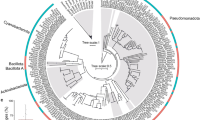Abstract
The Mallomonadaceae (Chrysophyceae), a group of flagellated algae commonly found in freshwater systems, are characterized by an armour of overlapping siliceous scales that are taxonomically diagnostic1. Mallomonadacean scales are usually abundant and well preserved in lake sediments2. Previous palaeolimnological studies have used the stratigraphie distribution of mallomonadacean assemblages to document patterns of lake eutrophication2–5. Our data demonstrate that the distribution of certain mallomonadacean taxa is also closely related to lakewater pH, that stratigraphic analyses of fossil scales can be used to indicate past changes in lake acidity, and that such stratigraphic studies provide important insights concerning the responses of sensitive lake systems to acid deposition.
This is a preview of subscription content, access via your institution
Access options
Subscribe to this journal
Receive 51 print issues and online access
$199.00 per year
only $3.90 per issue
Buy this article
- Purchase on Springer Link
- Instant access to full article PDF
Prices may be subject to local taxes which are calculated during checkout
Similar content being viewed by others
References
Takahashi, E. Electron Microscopical Studies of the Synuraceae (Chrysophyceae) in Japan (Tokai Univeristy Press, 1978).
Smol, J. P. Can. J. Bot. 58, 458–465 (1980).
Munch, C. S. Freshwat. Biol. 10, 61–66 (1980).
Battarbee, R. W., Cronberg, G. & Lowry, S. Hydrobiologia 71, 225–232 (1980).
Smol, J. P., Brown, S. R. & McNeely, R. N. Hydrobiologia 103, 125–130 (1983).
Smol, J. P., Charles, D. F. & Whitehead, D. R. Can. J. Bot. (in the press).
Schofield, C. L. Acidification of Adirondack Lakes by Atmospheric Precipitation: Final Report, Project F-28-R (New York State Department of Environmental Conservation, Albany, (1976).
Pfeiffer, M. H. & Festa, P. J. Acidity Status of Lakes in the Adirondack Region of New York in Relation to Fish Resources (New York State Department of Environmental Conservation, Albany, (1980).
Charles, D. F. thesis, Indiana Univ. (1982).
Cushing, E. J. & Wright, H. E. Jr, Ecology 46, 380–384 (1965).
New York State Department of Environmental Conservation Lake and Pond Survey records, Region 5, Ray Brook, New York, USA.
Driscoll, C. T., Jr, Baker, J. P., Bisogni, J. J. Jr, & Schofield, C. L. Nature 284, 161–164 (1980).
Cronberg, G. & Kristiansen, J. Bot. Notiser 133, 595–618 (1980).
Nicholls, K. Nova Hedw. 34, 88–124 (1982).
Kling, H. & Kristiansen, J. Nord. J. Bot. 3, 269–290 (1983).
Author information
Authors and Affiliations
Rights and permissions
About this article
Cite this article
Smol, J., Charles, D. & Whitehead, D. Mallomonadacean microfossils provide evidence of recent lake acidification. Nature 307, 628–630 (1984). https://doi.org/10.1038/307628a0
Received:
Accepted:
Issue Date:
DOI: https://doi.org/10.1038/307628a0
This article is cited by
-
Effects of climate change and industrialization on Lake Bolshoe Toko, eastern Siberia
Journal of Paleolimnology (2021)
-
Ecological distribution of scaled-chrysophyte assemblages from the sediments of 54 lakes in Nova Scotia and southern New Brunswick, Canada
Journal of Paleolimnology (2010)
-
The environmental history of a mountain lake (Lago Paione Superiore, Central Alps, Italy) for the last c. 100 years: a multidisciplinary, palaeolimnological study
Journal of Paleolimnology (1996)
-
Paleolimnological reconstruction of recent changes in assemblages of Cladocera from acidified lakes in the Adirondack Mountains (New York)
Journal of Paleolimnology (1994)
-
Historical loading record of sulfur in an Adirondack Lake
Journal of Paleolimnology (1993)
Comments
By submitting a comment you agree to abide by our Terms and Community Guidelines. If you find something abusive or that does not comply with our terms or guidelines please flag it as inappropriate.



